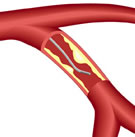|
The results of the prospective, multi-center trial at 12-months, originally published in the New England Journal of Medicine in 2009, demonstrate that patients with multi-vessel coronary artery disease who were treated by FFR guidance had a 34% reduction in death and myocardial infarction (MI) compared to angiographic guidance alone. The clinical benefit of FFR-guidance at two years showed the sustained reduction in death and heart attacks of 34%. The study also demonstrated that adhering to an FFR-guided regimen for multi-vessel disease provides cost benefits to the hospital and payers by reducing procedural costs by $675 and lowering average length of hospitalization. The data also showed that the implementation of FFR did not add time to the multi-vessel percutaneous interventional (PCI) procedure. William F. Fearon, M.D., associate director of interventional cardiology at Stanford University Medical Center, Palo Alto, California commented, "Use of FFR technology represents a rare opportunity in medicine in which an innovative product not only improves clinical outcomes but also saves money." "The FAME study results reaffirm that angiography alone is not enough," said Scott Huennekens, president and CEO of Volcano. "Better patient outcomes and lower costs are key global objectives and central topics in the U.S. healthcare reform debate. This study demonstrates significant clinical and economic benefits of FFR when used routinely to guide treatments of multi-vessel disease." FAME randomized 1,005 patients diagnosed with multi-vessel coronary artery disease at 20 European and United States centers to either angiography-guided PCI (n=496) or FFR-guided PCI (n=509) all using current drug regimens. Some physicians have been concerned that the lesions deferred by FFR may progress and cause future events. In the FAME study, 513 total lesions were deferred and only one of those lesions led to a myocardial infarction (heart attack) within two years (0.2 %). This highlights the effectiveness of using a 0.80 FFR threshold for triaging this multi-vessel disease patient population. "FAME is among the most important studies in today's drug eluting stent era," said Huennekens. "FAME data has driven a significant increase in the use of FFR in the last year, but despite the clear and positive clinical and economic impact of FFR guided PCI, without direct reimbursement for FFR, physicians are often discouraged from using the tool because the line item cost for the FFR wires is perceived as an added expense to the hospital. This is a perfect example of where the current U.S. reimbursement system works against patients, physicians and hospitals because it drives doctors away from these beneficial and proven guidance tools. The data show that both patients and hospitals benefit, yet the reimbursement structure may be slowing adoption of the technology." Volcano estimates that multi-vessel disease is treated in approximately 35% of all U.S. PCI (a combination of mutli-vessel stenting and patients who are staged and treated during two separate visits). By applying the FAME results across that patient population, the reduction in MACE and assuming $675 per procedure cost savings would result in approximately 18,000 fewer MACE events per year at a total hospital cost savings of approximately $230 million or over $2 billion in the 10 years outlined for the new healthcare reform package. If you count the cost savings included in the MACE reductions, as presented at ESC 2009 ($2,066 per patient) that potential total cost impact could be more than $700 million per year, and $7 billion over 10 years. Huennekens continued, "In the end, physicians want to do what is best for the patient. The data from FAME in support of FFR-guided PCI has clearly been strong enough to change practice, as sales of our disposable FFR wire products through the first half of 2009 have grown nearly 80 percent year over year. The extended 2-year follow-up data presented today from FAME provides further evidence of clinical benefit and hopefully continues to support changing physician guidelines as well as reimbursement practices." About Volcano Corporation Forward-Looking Statements Source: Volcano Corporation |


